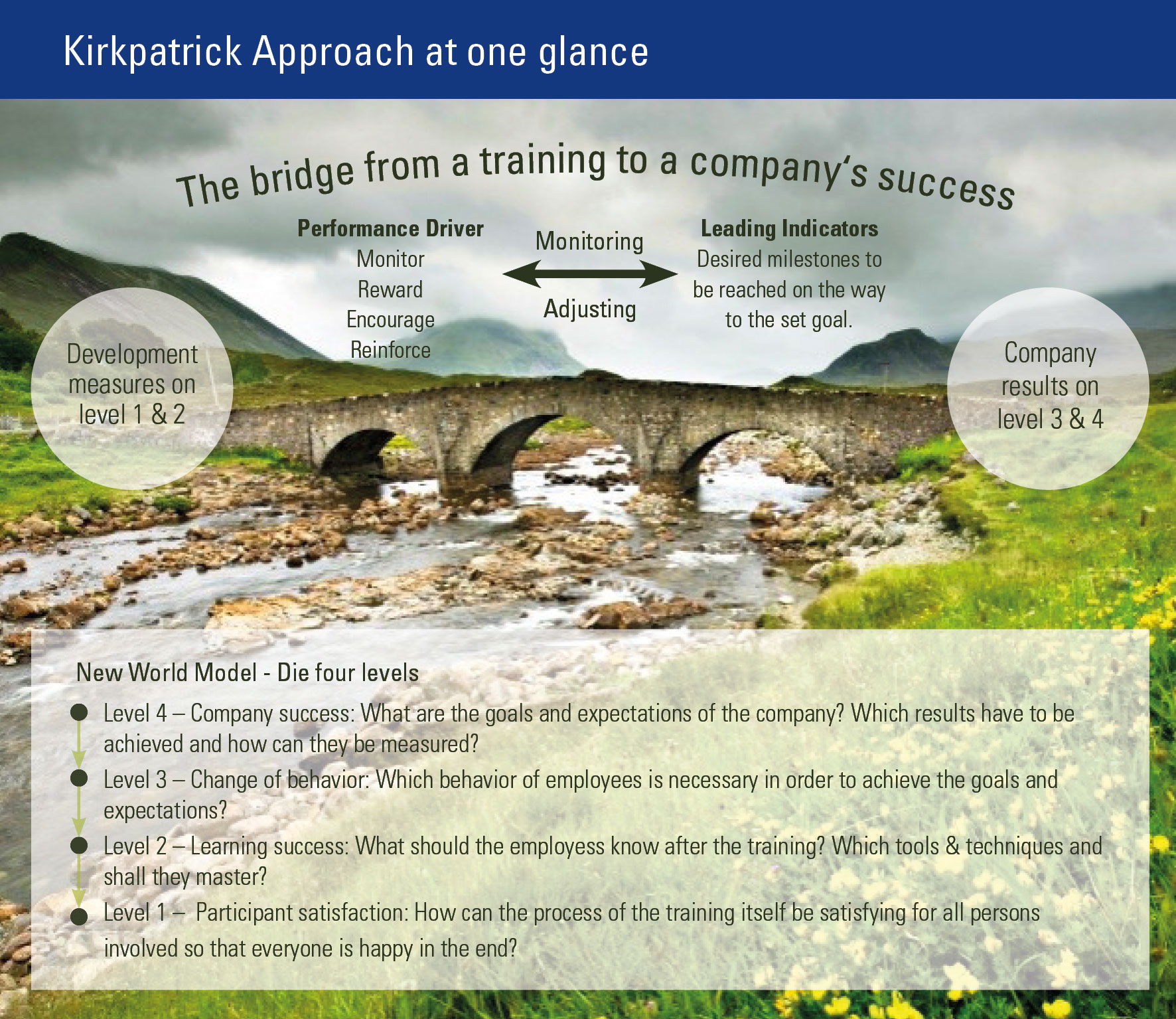Day in and out the following question bothers us: How can we ensure that learned training content is really applied in practice, leading to sustainable change of behavior? Today we’d like to show you the three most effective approaches we got to know during past years and which have proven themselves as really effective. Here we go with your power package for maximum training transfer.
In this article you’ll find:
- For any development measure, start with the end in mind with the Kirkpatrick New World Model
- Tools and interventions for any development measure with the 12 Levers for Training Effectiveness
- Make results digitally visible and measurable with the learning transfer platform Promote®
Real results need real training transfer
The base for a real contribution to business goals and creation of value by development measures is that learned training content is actually applied in daily work. This is called learning transfer or training transfer. To achieve learning transfer, there are a lot of pretended “one-fits-all-solutions” or single interventions on the market. Systematic and integrated approaches in contrast are rather seldom. Together with the Institute of Transfer Effectiveness we bundled the three most effective approaches for you and treat them in detail in the following.
Integrated approach with the Kirkpatrick New World Model
Originally development in the 1950ies, today the widely known but little applied model is more up-to-date and practicable than ever.
In the center is the motto: Start with the end in mind. This means: At the beginning of each development measures you should define your desired goals and results. Sound obvious, right? But in reality it’s often like that: A certain pain point occurs – a lack of communication skills, delegation or feedback errors, difficult decision finding processes, … – and yet a training to that certain topic is designed and launched. HR appears as internal provider and the performance measurement is done by so-called “happy sheets” after the training.
The four levels of effective training design and evaluation in the most reasonable chronological order are:
- Level 4 – Company results
- Level 3 – Change of behavior
- Level 2 – Learning success
- Level 1 – Participant satisfaction

Kirkpatrick New World Model – The bridge between development measures and company results
The model and it’s practical application intends to build the bridge between training and development measures on the one side and company goals and results on the other side. Therefore it offers valuable results and key figures.
ROE as a new key figure: The Return on Expectations describes the sum of expectations all stakeholders have multiplied with the rate of reach of achievement of that expectations. At the beginning it needs an agreement between all stakeholders that they are okay with being measured by that figure.
From provider to business partner: Due to fact that trainings and development measures do directly contribute to business goals, HR departments as well as external trainers and training suppliers and no longer mere service provider but can operate as real business partners within the organization. That claims mutual trust and sometimes also a little bit of courage.
Chain of evidence from concept to goal: The New World Model complements the Kirkpatrick approach with Leading Indicatiors – milestones on the way to your planned success – and so-called Performance Drivers – measures to boost learning transfer and application of new behavior. If monitored and regulated constantly, they deliver a conclusive chain of evidence about what does lead to which goal (nor not) and to which extent. In terms of controlling they also show you what to do and where to adjust to get back on your track or to stay there.
Trainer Masha Ibeschitz is the first and only Kirkpatrick Facilitator offering the Bronze Certification in the German-speaking area.

„I think it is always a good idea, if you can do things in a structured way. This is what I strongly notice at the Kirkpatrick approach and this is the reason why I’m a fan of this concept.”
Masha Ibeschitz
The 12 Levers of Transfer Effectiveness
HR managers, training providers and trainers often invest a lot of time and money in whorkshops, trainings and development programs for employees and leaders. Taking a look at the shocking numbers – only about 15-20% of participants apply what they learned in a training (compare studies from Brinkerhoff – you can quickly start to think words like waste of time and waste of money. And it’s no wonder that development programs often are the first victims of cost reduction measures within organizations.
This is where Dr. Ina Weinbauer-Heidel and the Institute of Transfer Effectiveness enters the stage. She is dedicated to active transfer research and analyzes the factors influencing successful transfer of learned content into daily work. In her dissertation the engaged scientist followed the question: How do Austrian organizations do currently try to ensure learning transfer before, during and after the training?
Her comprehensive survey and a lot of additional research have been the stumbling block for the 12 Levers of Transfer Effectiveness which are scientifically proven and practically manageable factors influencing transfer success. Knowing how to apply them means that you are able to develop tailor-made tools and interventions for any development measure in any organization.

„What makes training really effective? How can I solve the transfer problem in my training programs? I wanted to find and answer – an answer which is based on scientific research and simultaneously very hands-on. In its 100 years of history, transfer research developed remarkable and verifiably effective interventions. But who has the time to work through all the research results? That’s the reason for the 12 Levers of Transfer Effectivenes. They are based on research and ready for practice.
Dr. Ina Weinbauer-Heidel
The learning transfer platform Promote®
So far so good. With the two concepts above and Kirkpatrick combined with the 12 Levers you have effective development programs and suitable transfer measures. Only thing missing is the possibility to display all that in a transparent way to manage and measure it in real time.
So the third tool of success we experience daily is the learning transfer platform Promote. It’s easy to handle, simply and quickly adjustable for any measure, training or program and operable from anywhere. Therewith it’s not only the answer on how people do learn today but also the perfect complement to really bring to life any planned measures.
The tool is intuitive and user-friendly and has a lot of useful features coming with it like: creation and step-for-step measurement of individual targets, implementation of line managers as learning coaches, making learning progress of individuals visible and giving the possibility to directly react, eLearning elements, exchange with trainers and peers and much more.
What serves you next?
Mountain affair - Evaluation training needs and planning resasonably
At the beginning of any measure there is always a certain pain point – Department X isn’t efficient. Our team has problems with personal customer support. – and soon you hear “We need a training!”. Therefore training suppliers get instructed, topics get approved and dates get confirmed. Hardly anyone is asking: Is it really the training we need? What do we de facto need to reach our goals? A possible answer with our mountain impulse.
Learning transfer in practice – Reflection work: Circle of concern vs. circle of influence
Training is only effective and reasonable if learned things are applied in practice afterwards. But that’s exactly the difficult part! Visible learning transfer which is documented and therewith controllable isn’t easy to get. Targeted learning transfer measures, provided pre and post a training – for a example on a learning transfer platform – can do the trick. In our new series “Learning transfer in practice” we present just these transfer measures. Today: A reflection work on the circle of influence.
Synchronous vs. asynchronous eLearning
You would like to add-on eLearning components to the face-2-face trainings in your development initiatives? And thus create a Blended Learning Solution? That’s a great idea! We are sure you’re really enthusiastic about your plan, but before you go ahead there are a few things, that you should think about, in order to choose the right tool that fits your learners, the topic and last but not least your budget.




